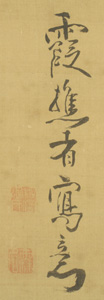Nanga
Bai - Plum blossomSigned: Kashôsha shai
Seals: Shinnei Ike shi, Mumei
Technique: sumi on silk 125 x 43
Mounting: Grey silk 197,5 x 58
Condition: remounted, very good
The first of six screen paintings. They are offered as a set of six.
Taiga has become the best-known and most influential Nanga painter of the 18th century. He was the son of a farmer and he worked at a fan-painting shop in Kyoto and engraved seals.
After an accidental meeting with Yanagisawa Kien (1704-1758) he became his student and learned the Chinese technique of finger-painting in 1738. He became friends with Kô Fuyô (1722-84) and Kan Tenju (1727-95), who also worked in Kien’s studio.
In 1746 he married the poet/painter Gyokuran (1727-84), the owner of a teahouse. Taiga was a frequent traveller and in Edo he got into contact with Western imagery through Noro Genjô (1693-1761), a rangakusha, scholar of Western learning. This meeting also had an influence on Taiga’s work.
After Taiga died his studio Taigadô became a kind of pilgrimage resort for his followers. (cat 20)
Taiga was born in Kyoto, son of a farmer who into Kyoto to workat the silver mint. At the age of three his father died and his mother provided him with good teachers and was sent to the Mampuku Ôbaku Zen temple at the age of six. When fourteen he he worked at a fan-painting shop in Kyoto and engraved seals. Yanagisawa Kien (1704-1758) became a main influence on his work after they met in a restaurant. Taiga went to study with Kien in 1738 and learned the Chinese technique of fingerpainting and became friends with Kô Fuyô (1722-1784) and Kan Tenju (1727-1795).
In 1746 he married Gyokuran (1727-1784), the proprietor of a tea house, with talents for poetry and painting. Taiga became an inveterate traveller and mountain climber. During one of his trips he stayed in Edo with Noro Genjô (1693-1761) a rangakusha, scholar of Western learning. He showed him the space in Western imagery, which became an influence on Taiga’s work.
After Taiga died his studio Taigadô became a kind of pilgrimage resort for his followers. Aoki Shûkuya (1737-1802) being its first head.
Reference:
Suzuki 1960
Suzuki 1996
Takeuchi 1992
Fischer 2007
Nihon bijutsu vol. 18
Roberts p.167
Rosenfield B 23
Price: ON REQUEST

